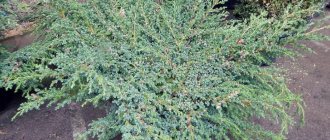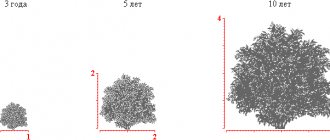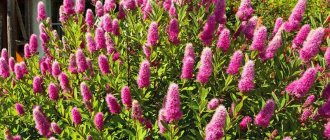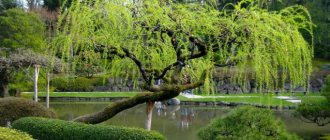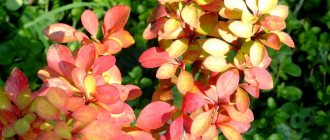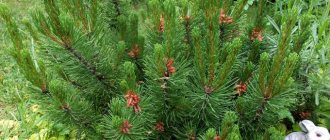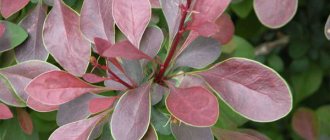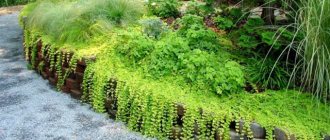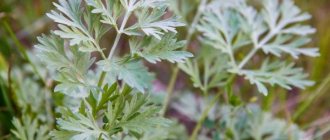You are always amazed by Mother Nature; she combines so many different types of beauty! Nothing man-made can compare with how beautiful plants are, even those that do not have obvious flowers, and the charm comes from the appearance of the leaves, like the ornamental shrub called "Barberry Admiration."
When you see this low, almost spherical plant in the garden, you cannot even believe that the fruiting barberry is a relative of it. Look how lovely the Admiration barberry is in the photo, isn’t it a miracle!?
Admiral's barberry in all its glory!
History of selection
China and Japan are considered the birthplace of Thunberg barberry. From there, the shrub spread throughout the world, and today it grows in Europe, Asia and North America. The species received its name from the Swedish botanist Carl Thunberg, who studied the nature of Japan and described several hundred varieties of the plant. Later, breeders developed new ones that differed in decorative foliage, crown shape and other properties. Thus, in the Booscope nursery in the Netherlands, a new variety of Thunberg barberry appeared - Admiration. In 2009, based on the results of the test, he was awarded a prize from the English Royal Horticultural Society. Today this variety is widely used by landscape designers and amateur gardeners.
Description of Barberry Thunberg Admiration and characteristics
According to the description and photo, Thunberg Admiration barberry is a deciduous shrub with red shoots that gradually darken and acquire brown tints. Its stems are short, highly branched, densely covered with thorns. The bark of annual shoots is brown, with a red tint; in a more mature state it becomes yellow-gray.
Barberry Thunberg Admiration can even be grown in pots, as long as there is enough space for the roots
The foliage is distinguished by its grace - the plates are oval-oblong, leathery, shiny, about 1 cm long, located on short petioles. In spring they are reddish in color, later they acquire more saturated shades, and an elegant yellow edging appears. They retain their bright color until late autumn, when the entire garden is already bare. On the shoots, the leaves are arranged in bunches and singly, in a spiral.
Barberry Thunberg Admiration blooms profusely, beginning in May and lasting about three weeks. The flowers are small, fragrant, collected in racemes.
The fruits are in the form of small elliptical orange berries, each up to 1 cm long, ripen in September. They are very decorative, edible, and remain on the bushes all winter. Flowering and fruiting begin at 5-6 years of plant life.
The root system of Barberry Thunberg Admiration is highly branched and located in the upper layers of the soil.
The variety is light-loving and can tolerate shading, but from a lack of sun the foliage turns green, the shoots become elongated, and the crown loses its shape. It is undemanding to soils, grows well on sandy or loamy soils with a neutral or slightly acidic reaction. The shrub is drought- and heat-resistant, prefers moderately moist, drained soils. The Admiration variety is winter-hardy and can tolerate frosts down to -40 ⁰C. In snowless winters, the tops of non-lignified shoots freeze over.
Barberry Thunberg Admiration - an excellent honey plant
Height of Barberry Admiration
The shrub grows very slowly, its annual growth is 2 cm in height and no more than 5 cm in width. Admiration is a dwarf variety, which in adulthood, at 10 years old, reaches a height of 60 cm and 1 m in diameter. The shape of the crown is round, almost spherical, but not entirely uniform.
Important! The average lifespan of a shrub is 50 years.
Varietal diversity
Today, gardeners cultivate many varieties of Thunberg barberry. Among the varieties that are in greater demand, several varieties should be noted.
A shrub of regular shape, reaching a height of 70-80 centimeters. This culture is distinguished by its slow pace of development, which will be a big plus for some garden compositions. Berberis thunbergii Aurea is distinguished by its good survival rate and compatibility with other garden crops, which allows you to create beautiful colorful compositions in the garden.
Erecta
A columnar-shaped bush that can grow in height up to 1 meter. Shoots develop in a horizontal position, but side branches can grow at a slight angle. The variety is notable for the bright green color of its leaves, resistance to negative temperatures, and ability to develop when planted in a mixborder.
Green carpet
A cushion-shaped variety of barberry, in which shoots develop in different directions. The height of the crop reaches 50-60 centimeters, while the width of the shrub can grow up to one meter. The color of the green mass of barberry will be light green, the crown has a spherical shape. At the end of the summer months, barberry changes the color of its leaves to red.
Golden ring
Barberry with purple leaves edged with gold. The crop tolerates frost well and is most often used in border compositions and also as a hedge.
Red rocket
Variety with purple leaves. The crown of the bush has a columnar shape. As a rule, the height of an adult plant is within one meter. The shoots develop strictly horizontally and contain smaller lateral branches. The variety can be used in single or group plantings.
Bagatelle
A shrub with a spherical crown, having a brown-red color of green mass. The plant is small in size. As a rule, the height of an adult bush reaches 40-50 centimeters. Over the course of a year, it increases by only a couple of centimeters. In spring and summer, the leaves of barberry will be dark with a pink tint; inside the shrub has green foliage, which remains unchanged in color even with the arrival of autumn.
READ MORE: Sofas 2021 - features of the choice of modern models (112 photos)
Admiration
The most popular variety of barberry, standing out for its beauty. The crown of the plant has a spherical shape, the height reaches 30-40 centimeters. The bush grows quickly - within a year, barberry can increase in height by 3-4 centimeters, while the plant will become 2 times larger in width. The variety belongs to the light-loving varieties of barberry and is undemanding to the type of soil.
When planting this barberry, it is worth considering that the bush grows its shoots quite slowly. The branches develop horizontally; as a rule, the height of an adult bush is 150 centimeters. The crown will be columnar and dense; young shoots are usually pink and orange. The green mass has a yellow tint with a pink border around the edge; in the fall the bush will be bright orange.
Flowering occurs in May, while the fruits ripen only in October. For the culture, it is worth selecting sunny areas in the garden; barberry quickly recovers after cutting and can act as a topiary crop. The variety is frost-resistant and can be used to create border compositions and rock gardens.
In addition to the above varieties of Thunberg barberry, gardeners grow the following varieties:
Advantages and disadvantages of the variety
The miniature size allows the Thunberg Admiration barberry to be used for a wide variety of landscape compositions. This is not the only advantage of the plant, thanks to which its popularity is increasing.
The barberry bush can be planted in open areas, because it is not afraid of winds
The advantages of the variety include:
- compactness of the bush;
- brightness and decorativeness of foliage;
- adaptability to changes in weather conditions;
- undemanding to soil composition;
- frost and drought resistance;
- loyalty to haircut and pruning;
- ease of care;
- long flowering;
- pleasant aroma;
- the presence of beautiful edible berries;
- resistance to pests and diseases.
The Thunberg Admiration barberry has few disadvantages:
- greening of foliage when planting shrubs in the shade;
- slow growth;
- poor tolerance to soil waterlogging;
- prickliness;
- possibility of freezing of immature shoots.
In autumn, on the Thunberg Admiration barberry, red berries appear in place of flowers.
How to properly care?
In order for the crop to be successfully grown in open ground, the basic nuances regarding agricultural technology must be observed.
The shrub does not need frequent watering. Gardeners also note that the plant remains viable even in the summer months during periods of drought. In general, natural precipitation in the form of rain will be sufficient for barberry. To help the soil retain moisture, it is recommended to make holes around the bushes and, if watering is necessary, introduce moisture under the roots, avoiding wetting of the green mass.
Top dressing
The plant responds well to the introduction of additional fertilizing. Among the available list of substances that can be used as fertilizing, it is recommended to focus on organic compounds, for example, use compost or humus. Fertilizers are usually introduced in the spring. You can combine these activities with digging up the soil. In the fall, you should limit yourself to a layer of peat mulch laid in a circle near the trunk.
READ MORE: The best ideas for a summer cottage - design ideas for a summer house and rules for arranging a summer cottage 105 photos
Trimming
The culture does not require mandatory shaping. It will be necessary to trim barberry only when the gardener is faced with the task of shortening too long shoots that interfere with the decorative attractiveness of the crown. However, it will be necessary to form the bush by pruning during annual sanitation work in the spring.
Methods of propagation of barberry Thunberg Admiration
Like most varieties, Admiration can be propagated in one of four ways. Each of them is used by gardeners depending on opportunities and circumstances.
Seeds
It is necessary to act according to the algorithm:
- In late autumn, ripe berries are collected.
- They are separated from the pulp, washed in water and a solution of potassium permanganate.
- Dry it.
- Two weeks before the first autumn frosts, they are sown in a ridge to a depth of 3 cm.
- In the spring, after the emergence of seedlings, they are thinned out.
- Two years later, the seedlings are transferred to a permanent place.
Important! Sowing can be done in the spring, provided that the seeds are stratified for three months in the refrigerator in the winter.
Cuttings
The propagation option by cuttings involves the preparation of planting material in June. For this purpose, cuttings are cut from an adult barberry Thunberg Admiration, leaves are removed from them, except for the apical ones, and placed in Kornevin’s solution for several hours. After this, they are planted in moist soil and shaded. The seedlings are ready for transplanting after 2-3 years.
By layering
To obtain a new plant, select a healthy one-year-old shoot, bend it to the ground, place it in a prepared trench 10 cm deep and pin it. The top should be above the ground. Cover the stem with soil and moisten it. At the end of the season it should take root and begin to grow. Next year, the new plant is separated from the mother plant and planted in the chosen location.
By division
The propagation option by dividing the bush is reliable and does not require much time. In early spring, the bush is dug up and divided using a knife, pruning shears or garden saw. Each of the “divisions” should have at least 2-3 shoots and large, branched roots. The sections are treated with crushed charcoal and the plants are planted in prepared pits.
Over the course of a year, the growth of barberry Thunberg Admiration is only 15-20 cm
Characteristics of the variety
Let's start the description of Admiration barberry with its appearance. This plant is a low shrub up to sixty centimeters high and up to one meter wide. At first, with a size of 30 by 30 centimeters, the crown of the plant is almost spherical; with further growth, the bush becomes wide and squat.
Its decorative effect lies in the extraordinary purple coloring of the leaves, bordered by a golden stripe. The depth of leaf color varies with the season and depending on growing conditions. The leaves become brightest with the first frost.
This plant is light-loving, but tolerates partial shading, it is undemanding to the soil, drought-resistant and frost-resistant, which allows it to be grown in the conditions of central Russia and some northern regions.
The Admiration variety belongs to the Thunberg barberry species, named after the Swedish naturalist and student of Carl Linnaeus, Carl Peter Thunberg.
Do you know? In addition to our barberry, about three hundred plant species and several genera are named in honor of Thunberg. The most famous plant that received his name is called “Thunbergia”. This is a charming flower of the Acanthus family.
Planting and caring for barberry Thunberg Admiration
To plant barberry, choose a sunny place or an area with slight partial shade. If plants are planted as separate bushes, prepare holes 50 cm deep and wide; when creating a border, trenches are dug with the same parameters. If the groundwater level is high, a drainage layer is created, and a soil mixture of sand, humus, and garden soil mixed in a 2:1:1 ratio is poured onto it. The seedling is placed in the center of the hole, the voids are filled in, and the soil is compacted a little.
Further care for Thunberg Admiration barberry consists of watering, weeding, fertilizing, protection from diseases and pests.
Moistening the soil under the bushes must be done regularly, especially at first. You can retain moisture by mulching it with a layer of 4-6 cm. Later, as the plant develops, it is easier to tolerate dry periods and gets by only with periodic precipitation.
Barberry Thunberg Admiration responds to fertilizing by improving the quality of foliage and more active vegetation. Fertilizers are applied twice per season: combined mineral fertilizers in the spring and ash during the flowering period.
The peculiarity of the variety is that it does not require cutting. Barberry Thunberg Admiration is able to independently maintain its ideal shape for many years. Only sanitary pruning is carried out, removing diseased or injured branches.
To achieve flowering, you need to grow at least two barberry bushes for cross-pollination.
Growing conditions, planting
No matter how unpretentious an ornamental plant is, before planting, you still need to familiarize yourself with its characteristics and try to create conditions under which it will reveal its qualities to the maximum. Otherwise, the expected effect may not be obtained.
Related article:
Privet bush
Selecting a location
Variegated crops need sunlight to support their decorative effect, so Admiral barberry is planted in sunny or lightly shaded areas for a small part of the day. Planted in the shade, it will change the color of the leaves - it will be less bright or with a predominance of green tones, the shoots will become very elongated, and the crown will lose its attractiveness.
Resistance to frost is high, so growing the crop is possible in the regions of the middle zone and in some areas of northern latitudes.
It is believed that barberries are not too demanding on the composition of the soil, but Thurnberg Admiration grows better on light soils with neutral acidity and without stagnant moisture - the groundwater level is not higher than 1.5 m. It will tolerate slight salinity. The best soil mixture for filling a planting hole is sand and humus (1 part each) + turf or garden soil (2 parts).
Related article:
How to help plants survive the winter: 7 autumn feedings for berry bushes
If the soil is acidic, the bush develops very slowly and fruits are not formed. The way out of the situation is to add slaked lime (350 g) or wood ash (250 g) under each bush.
Landing rules
Admiration seedlings are purchased in nurseries and specialized stores. If the root system is closed, that is, it is in a clod of earth (in a pot, container), then it can be planted at any time from spring to autumn. If the root system is open, then the bush is planted immediately. You can delay planting time for a short time by burying the roots or wrap them in a wet cloth and place them in a bag. When planting in autumn, you need to take into account that the plant must take root and adapt to the new place before the onset of cold weather.
Related article:
Forsythia bush
Before planting, exposed roots are soaked in water for a day, adding a little manganese or a root growth stimulator. Vertical cuts are made on the lump of earth to stimulate the growth of lateral roots.
How to plant:
- prepare a planting hole, the size of which is slightly larger than a clod of earth;
- pour drainage at the bottom (sand, small pieces of brick, crushed stone, pebbles);
- fill with water and leave for 70-10 days;
- roll over the bush without destroying the lump, fill the voids with prepared soil;
- if the roots are open, then pour a mound in the center of the hole, place the seedling on it, straighten the roots, cover it, lightly compact it (leave the root collar at soil level);
- when forming a hedge, it is better to plant in trenches, leaving a distance of 40-50 cm between plants;
- water, apply a layer of mulch from humus, compost, leaves, grass, peat to reduce moisture loss;
- shorten the shoots, leaving 3-5 buds on each - this will allow rooting to take place faster.
Pests and diseases
The greatest danger to the Thunberg Admiration barberry is aphids and flower moths.
Aphid colonies suck the juice from the leaves, as a result of which they become deformed, dry out and fall off, and buds do not form.
The moth attacks the fruits of the plant. To combat insects, use an infusion of tobacco dust in a soap solution or chemical agents - Decis, Fufanon.
Under unfavorable weather conditions, planting diseased plants next to barberries, or violation of agricultural practices, fungal diseases may occur: powdery mildew, spotting, and wilting of shoots.
In the first case, the foliage and stems become covered with a white coating, and later they curl and dry out. As a treatment, spraying with sulfur-containing preparations is used several times a season.
When spotted, the leaves of Barberry Thunberg Admiration acquire an uneven color, dry out and crumble. Barberry is weakening and may not survive the winter. To combat pathology, drugs containing copper are used. Treatment is carried out twice per season - before and after flowering.
It is difficult to combat wilting - first individual shoots dry out, and then the whole plant. If you cut a branch, you can see dark vessels. The affected parts of the plant must be cut out and burned.
Care
If the conditions for normal growth are initially created, then caring for barberry is not difficult - watering is necessary, based on weather conditions, and infrequent feeding.
Related article:
TOP 7 ornamental shrubs that will become a real decoration of the garden
Care stages:
- Watering, loosening. After planting, watering is carried out after the top layer of soil has dried, preventing the clod of earth from drying out. In the future, watering is not frequent, but plentiful - the soil should be deeply saturated with moisture. Water is poured in portions, waiting for the previous one to be absorbed. You cannot allow water to stagnate between the roots - the plant may die or get sick. The soil is loosened several times a season to restore the oxygen supply. When applying mulch, they loosen less often, since the soil underneath is less compacted.
- Feeding. There is no need to apply fertilizers for the first two years - there are enough nutrients for now. Then they begin to feed - in the spring with nitrogen fertilizers, for example, a urea solution (20-30 g / 10 l), in the fall - with phosphorus-potassium complexes. The interval between fertilizing is 3-4 years. If it is a hedge, then fertilize it more often - every 2 years.
- Trimming. Admiration grows slowly, but pruning is necessary to maintain the health and formation of the desired crown shape. In early spring, dry, damaged branches located close to the ground are pruned, and in summer the crown is given the desired shape.
- Preparing for winter. The variety is frost-resistant, so adult plants do not require shelter and can easily tolerate temperatures down to -35 °C. It is recommended to cover the young plant with spruce branches and dry leaves.
Related article:
What ornamental bushes should I plant in my dacha?
Barberry Thunberg Admiration in landscape design
The bright color of the foliage, the small size of the plant, the density of the crown and its ideal shape provide enormous opportunities for using the Thunberg Admiration barberry to create unusual compositions. Bushes can be planted next to other varieties that have a columnar shape and contrasting color.
The Thunberg Admiration barberry looks great next to coniferous plants - thujas, spruces, junipers
Planted near large boulders, dwarf Thunberg barberries give an unusual look to the site, garden or local area. In city parks and streets, Admiration grade is used to create curbs, the space becomes more formal, and the lines become clearer.
Plants located at a distance of 35 cm from each other look very impressive several years after planting. The spherical bushes turn into a single array, a bright flower bed, the lifespan of which is at least 15 years.
Landscape possibilities
The spectacular color of the crown of the Admireish variety justifies its use for decorating areas. The shrub is planted at the dacha, in the garden and park area, near the coastline of water bodies. The small size of the bush contributes to the following planting options:
- tapeworm. A single red-leaved plant will complement an assemblage of dwarf conifers and deciduous trees with a dense crown (arborvita, spruce, spirea);
- rock garden element. In combination with boulders above 0.5 and rock fragments it creates the effect of a natural alpine slope;
- border. Geometric lines of barberry bushes will serve as a beautiful frame for flower beds, paths, memorials, historical sites and alleys;
- array. The square-nest planting method will allow you to create a bright replacement for standard flower beds and ridges.
The labor costs for arranging barberry compositions will be repaid by the spectacular appearance of the site. With proper care of the plant, you can get an excellent addition to your garden plot in the form of a picturesque dwarf shrub with an unusual appearance.
Sources:
- https://www.ogorod.ru/ru/outdoor/trees/13678/10-sortov-barbarisa-kotorye-ukrasyat-vash-sad.htm
- https://idachi.ru/sad/dekorativnie/barbaris-admirejshn.html
- https://fermilon.ru/sad-i-ogorod/kustarniki/barbaris-tunberga-admireyshn-admiration.html
- https://stroy-podskazka.ru/barbaris-tunberga/opisanie/
- https://stroy-podskazka.ru/barbaris-tunberga/golden-ring/
- https://m-strana.ru/design/barbaris-kustarnik-posadka-i-ukhod-dekorativnye/
- https://stroy-podskazka.ru/barbaris-tunberga/admirejshn/
- https://7ogorod.ru/plodovye-kusty/barbaris-admirejsn.html
